Everything you need to know about weighted blanket for kids, with and without autism from an occupational therapist. Get the best weighted blanket for your kid in 2024 or make a DIY!
Weighted Blankets for Kids: Everything You Need to Know
Have you ever had trouble sleeping? How about your child?
I remember when I showed up at Charlotte’s house for the first time, I was her occupational therapist.
Her mother immediately said to me, “What can I do to get her to go to sleep, take a nap, and stay asleep? I can’t keep going on like this.”
I saw her bloodshot eyes, and could feel the stress radiating from her, understandably so!
As we talked, I learned that her mom was doing a lot right. She was consistently putting her to bed at the same time. She had a relaxing bedtime routine. She had plenty of opportunity for physical exercise. She ate well.
I wondered if there was some sensory issues, or as I’d rather say sensory “needs”, that were causing Charlotte difficulty going to sleep.
In which case a weighted blanket could help everyone have some better sleep because sleeping with a heavy blanket can have a calming effect on the nervous system. To figure out if Charlotte might benefit from extra weight in her blanket, I asked a few important questions:
- Was she active, did she like jumping and climbing? (She answered YES!)
- Did she have a hard time laying still, was she fidgety? (Again, yes.)
- Did you ever notice her climbing into tight spaces? (Yup.)
- Does she like blankets? (Yes!)
In this case, Charlotte very well may sleep better with a weighted blanket on top of her, specifically for kids. If you can answer yes to those questions and your child is struggling to sleep well, they might too!
What is a Weighted Blanket for Kids Exactly?
While it may seem strange, a weighted blanket is exactly what it sounds like, a blanket that literally has small weights inside of it. The goal is to make the blanket so it’s a little heavy and applies deep pressure stimulation all over the body that is underneath of it!
Weighted blankets come in all sorts of sizes, textures, and different weights. They can be effective for a wide range of kids from little kids as young as 2 or 3 to older children at age 7, 8, 10 years old and beyond.
If you have any concerns about your child’s age, weight, or health conditions, talk to your child’s pediatrician before using any weighted blanket.
Another twist on the weighted blanket are weighted lap pads, which is simply a pillow or pad that’s heavy and can be laid across the lap. This also gives that same deep touch pressure for tasks during the day. Think of kids struggling to sit still at the dinner table or at school.
Weighted Blankets and the Sensory Connection…
As with Charlotte, weighted blankets can have an almost magic affect on some kids sleep problems. The constant pressure can be very relaxing, decrease anxiety, and help the body transition into sleep.
For some kids (and adults) that have trouble sleeping, the problem lies in their brain and the body’s ability to actually calm down. For those of us that sleep well, it’s something we take for granted, but an actual shifting of gears takes place in our mind to physically prepare our body for sleep.
When easing into a lower state of arousal isn’t possible, weighted blankets can be a physical aide to help our kids drift into sleep.
This difficulty with switching between our arousal levels is often linked to sensory processing. If that’s a new word for you (and it is for a lot of people), make sure you check out the beginner’s guide to sensory.
In particular, weighted blankets give proprioceptive input and tactile input. That input can be very calming and relaxing in general. It’s also why weighted blankets can also be used to relax at any time, not just for sleep. Look for more ways to use a weighted blanket at the end of the post.
If you’re looking to incorporate using a weighted blanket as part of your sensory diet, head to the Free Sensory Diet Template. And, if you don’t know what a sensory diet is, then check out “What is a Sensory Diet“.
Are Weighted Blankets for Autism or All Kids?
Some children don’t process information from their senses as well as others, so they seek it out or avoid it more. A lot of children have unique sensory needs, and may respond well to a weighted blanket, and have no diagnosis.
But, kids with special needs like Autism Spectrum Disorder (ASD) and Sensory Processing Disorder (SPD) have definite sensory needs, which is why weighted blankets are often recommended for kids with these diagnoses.
But, sensory needs are unique to every individual, diagnosis or not. And, weighted blankets are an investment in money and/or time, if you’re making one yourself.
While it may be tremendously helpful for a child or adult with or without sensory needs, Autism, or SPD to use a weighted blanket to improve falling asleep or staying asleep, it also may not at all. In Charlotte’s case, she had no diagnosis, and the weighted blanket helped her a lot. She stopped climbing out of her bed so much and slept through the night when she had it on.
At the same time though, I’ve seen plenty of kids that it just didn’t work for. Kids that refused to try or screamed at the top of their lungs when it was laid on top of them.
That’s why it’s worth your time thinking through some signs that your child may or may not like a weighted blanket, because if they don’t like it, they won’t use it. And, we never want to force them to.
Signs Your Child May Respond to a Weighted Blanket:
- Loves sleeping or laying under piles of blankets or heavy comforters.
- Enjoys crawling into tight spaces or behind furniture
- Has difficulty (even after a lot of physical activity) relaxing and sitting still
- Likes wearing heavy sweatshirts and sweaters
Signs Your Child May Not Respond to a Weighted Blanket:
- Is tactile defensive (very sensitive to touching different textures)
- Does not like sleeping or laying under blankets
Of course, these lists are not absolute and aren’t guaranteed. If your child is old enough, I’d show them pictures of one online and explain what it is and how it feels. Ask if they think it would help them. Kids are often very tuned into their needs and will give honest answers.
Non-verbal or are autistic children may be confused by the weighted blanket initially, it’s important to demonstrate how to use it and slowly introduce it in these cases.
As I mentioned earlier, sometimes weighted blankets are used during the day to help calm kids down, but for kids that are very active and seek out a lot of motion, this could really agitate them. Some kids will only respond to them during sleep.
Lastly, if you happen to be working with an occupational therapist, ask if they have any available for you to “try” for a short period.
Affiliate links used below. See our full disclosure.
The Best Weighted Blankets for Kids in 2025
There are actually several types of weighted blankets, so once you determine you’d like to try one, you’ll have to decide on what kind you’re actually going to get.
(Please make sure you check to make sure you get the right weight for your child, see the guidelines in the following section).
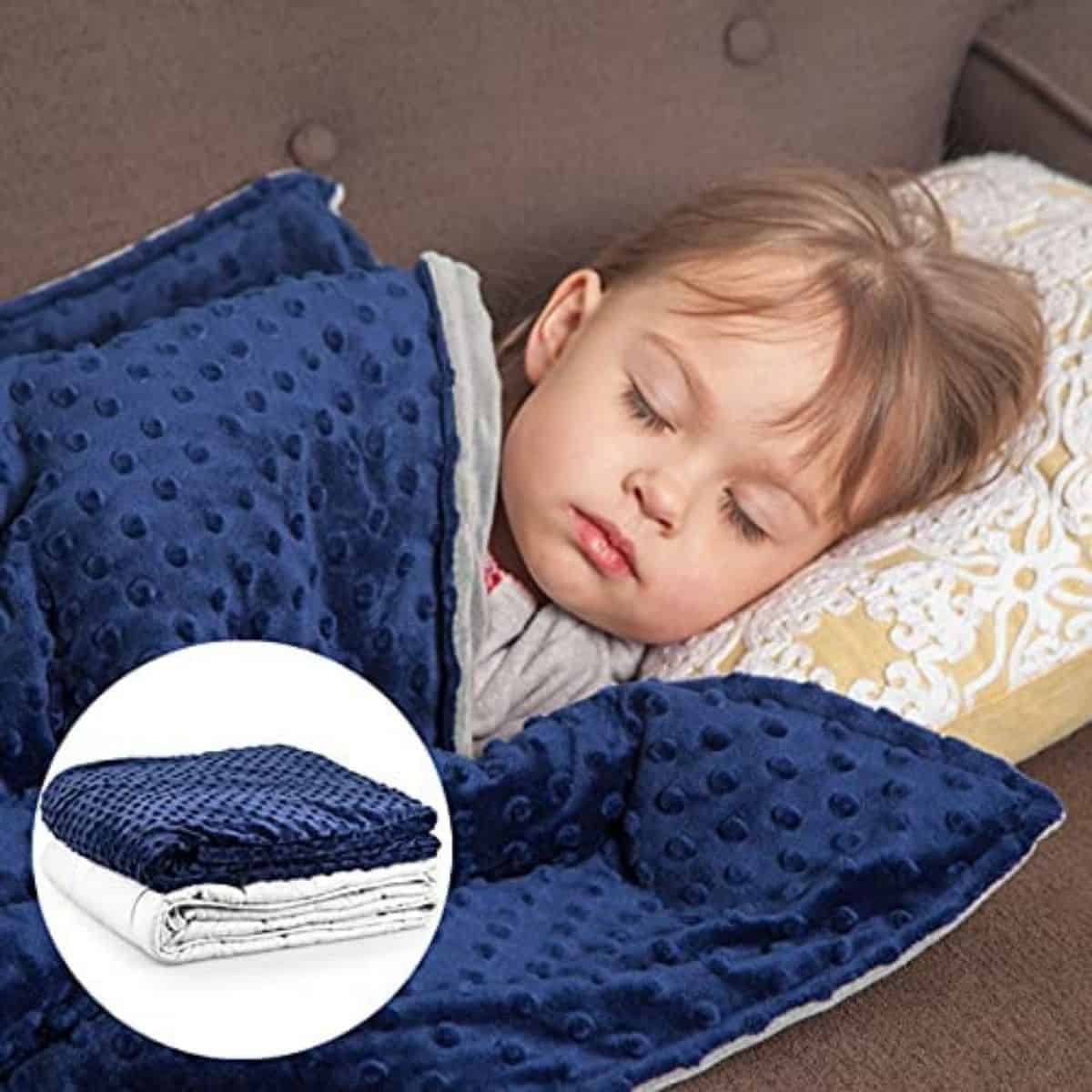
1. Soft Weighted Blanket with Duvet Cover– This weighted blanket has plastic pellets that are easily distributed throughout the blanket, which is my favorite way to have the weight distribution on a child. The soft outside has a removeable cover so you can throw it in the washing machine! Very budget friendly too!
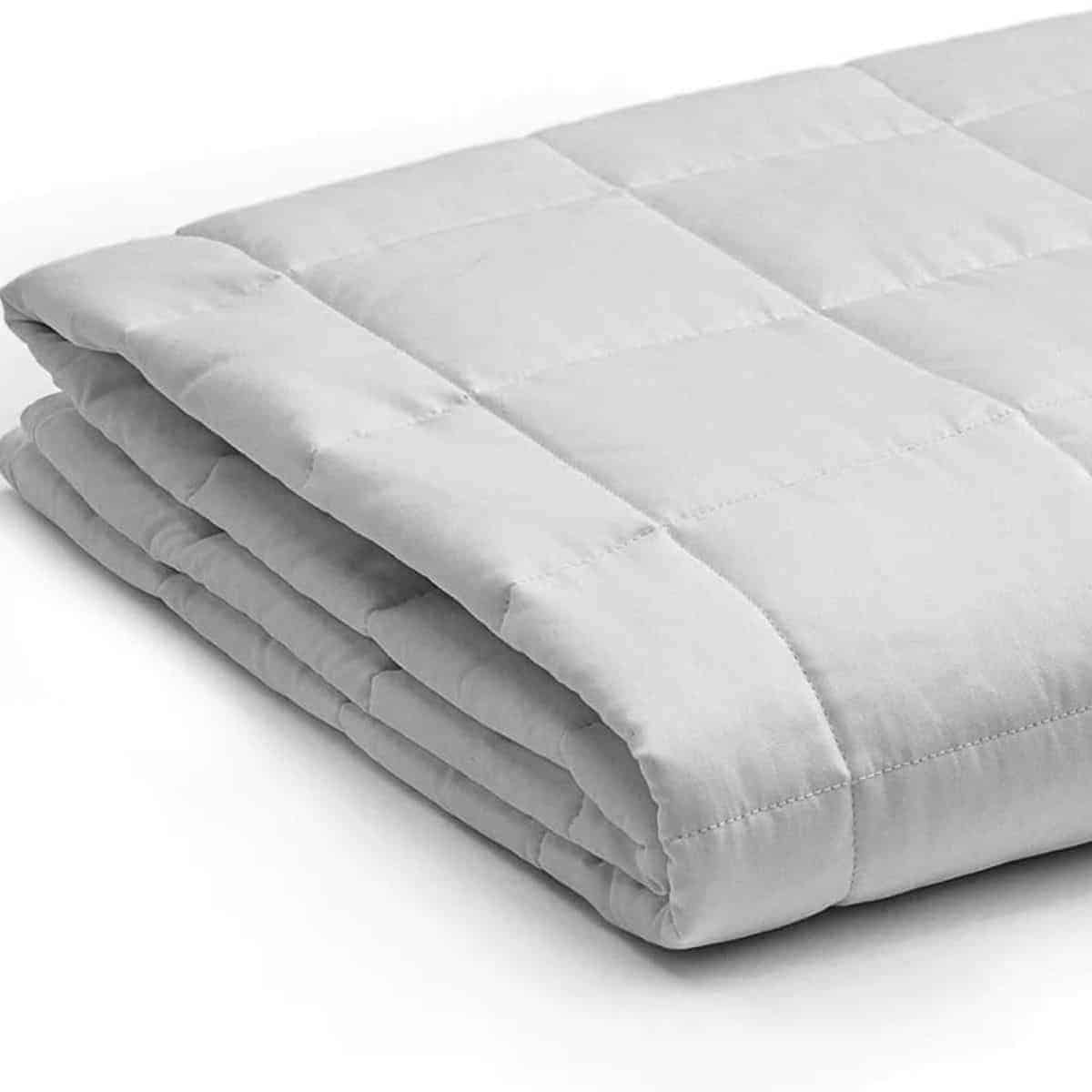
2. Pocket Weighted Blanket – The majority of weighted blankets are created with a series of small squares, each holds a set of weights. These blankets often come in a wide variety of textures and colors. This weighted blanket contains glass beads and is made of a breathable fabric, cotton. This blanket is not machine washable, but you can put a duvet cover on top.
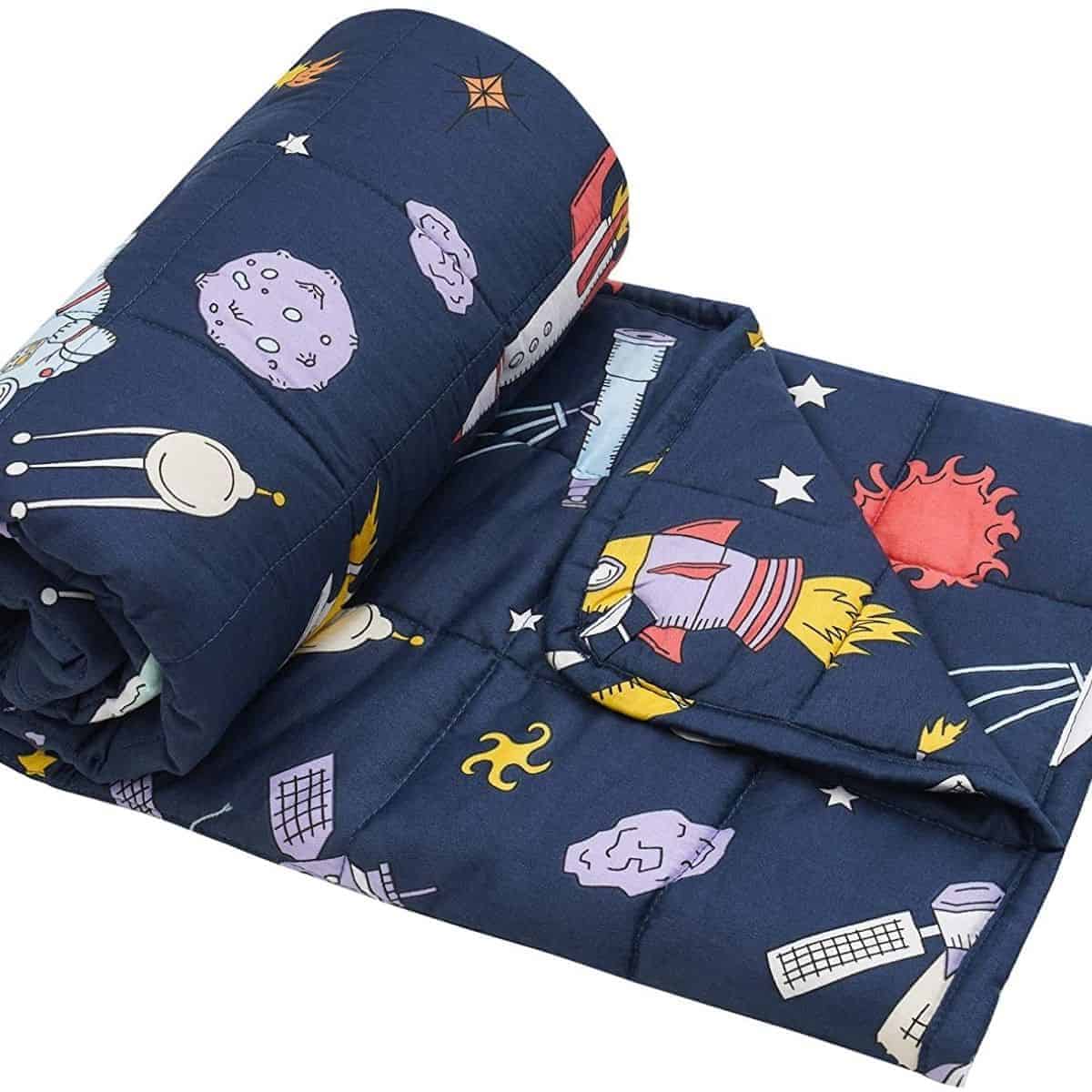
3.Budget Toddler Weighted Blanket – Although this comes in heavier weights for older kids, younger children may enjoy having animals, dinosaurs, or spaceships on them! This is also one of the lowest priced weighted blankets I’ve seen.
4. Wearable Weighted Blanket – Your child can slip inside of this wearable penguin blanket and literally walk around or sleep in like a sleeping bag.
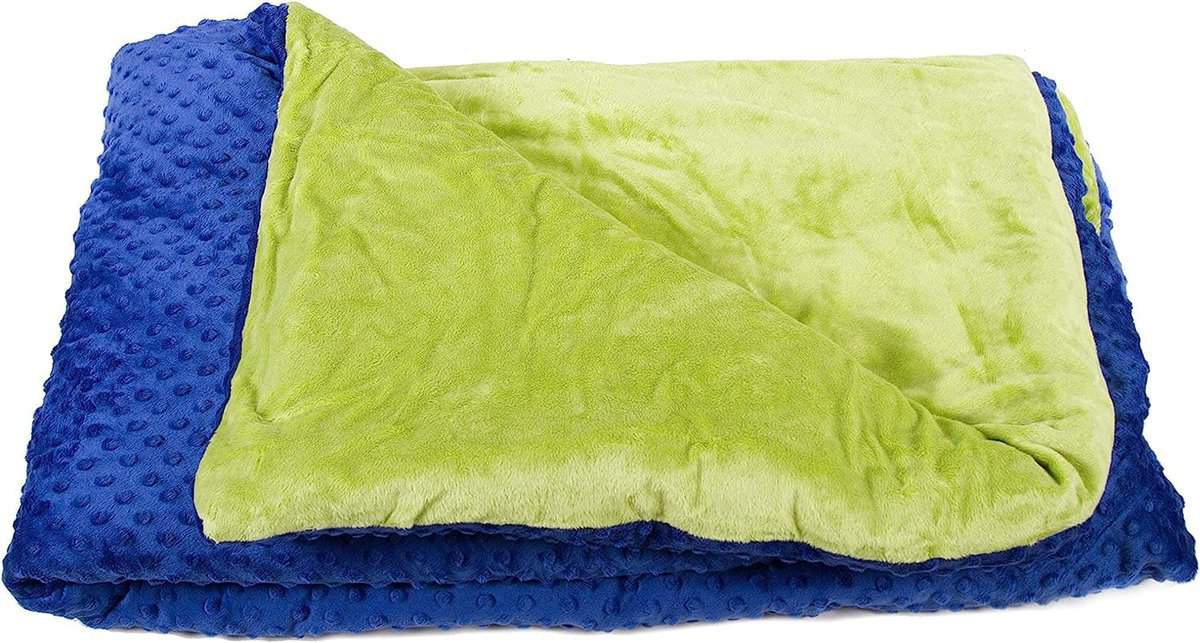
5. Harkla Weighted Blanket – A trustworthy sensory based brand, this blanket also has pellets in it that add weight and it comes in 4 different weight options! It’s covered in a duvet for easy washing!
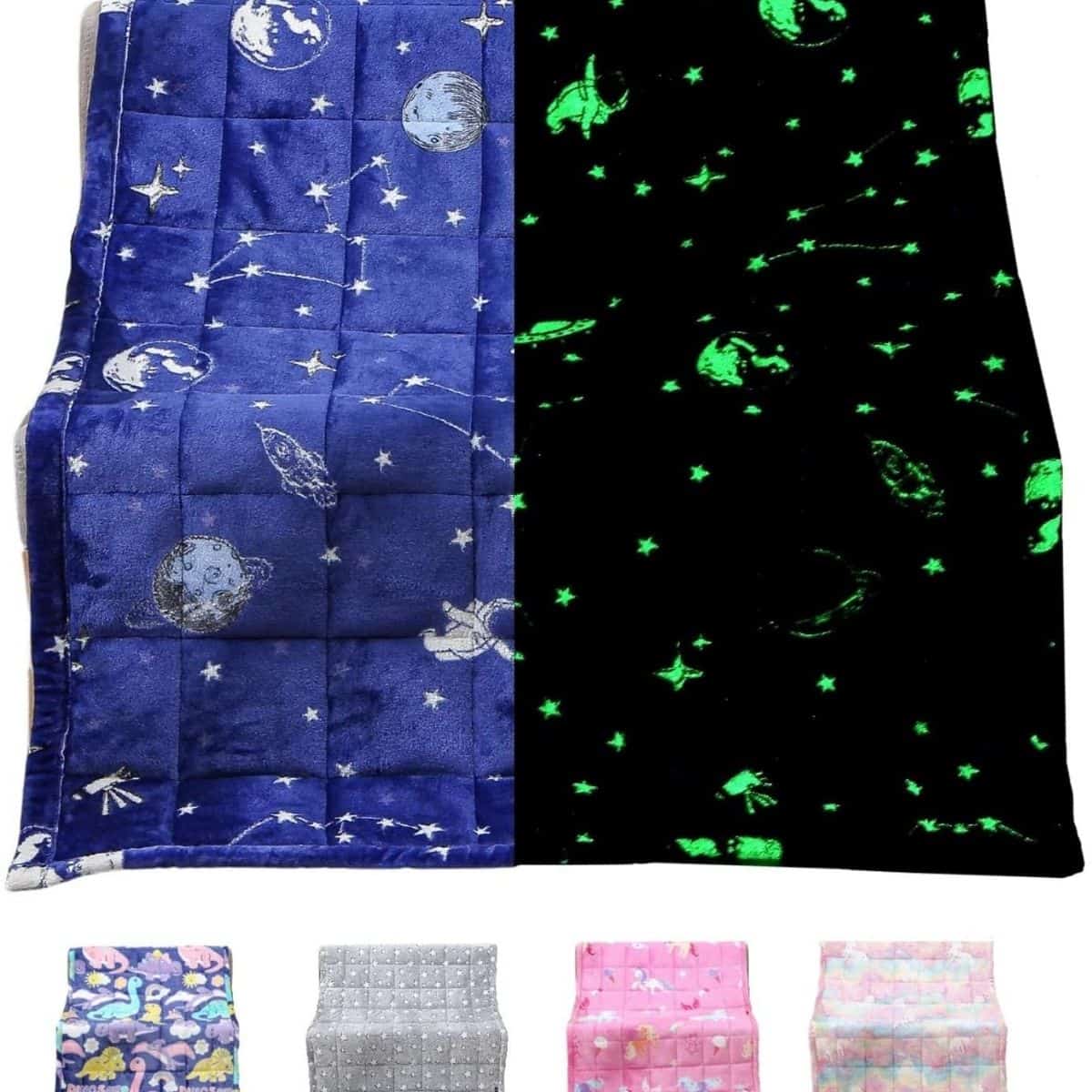
6. Glow in the Dark Weighted Blanket – If your kid is afraid of the dark, having this fun weighted blanket with special images that only appear when the lights go out could be very calming for you child! Made of minky plush and flannel. This can be machine washed in a bag or hand washed.
7. DIY Weighted Blanket – While they do require some time, they aren’t overly complicated and I’ve known a lot of people to make them. If you want an inexpensive weighted blanket and are willing to dabble in some sewing, this may be a great option for you!
Recommended Blanket Weight for Kids!
It’s important that you don’t put too much weight on your child when using a weighted blanket. They need the right weight that matches their body weight.
As a general rule, the weight of the blanket should be roughly 10 % of a child’s body weight. Going over or under a pound is usually fine.
For example, if your child is 40 lbs., a small weighted blanket should be around 5 lbs. However, a 3 lb. weighted blanket could also work. Ask your child how it feels and if your child has any health conditions, discuss using a weighted blanket first with your child’s pediatrician.
How to Use a Weighted Blanket for Kids
This may seem a bit obvious, but I want to give you some more ideas for how to use your weighted blanket!
- First and foremost, NEVER force a child to use a weighted blanket. You can demonstrate on yourself and encourage, but remember we’re talking about sensory input and a weighted blanket may actually feel painful to your child.
- When first presenting the weighted blanket to your child, pull it up slowly from their feet and lay it down on top of them. Ask them what they think!
- If your child could benefit from some calm down time outside of bedtime, try wrapping the weighted blanket around them while they sit on the couch or floor while reading, playing board games, doing homework, etc.
- Put inside a sensory tent that you use as a place to calm down. Your child can go in and use it whenever they need it!
- Weighted blankets can also be used in a classroom setting, as part of a sensory diet. Some classrooms have sensory tents or corners of their own. Head to Sensory Strategies for the Classroom to learn more.
Beyond Weighted Blankets for Kids, with More Sensory Activities…
If you’re looking for more ways to help your child calm and focus throughout their day and not just at bedtime then check out our free workshop: 3 Expert Secrets to Calm and Focus Your Child with Specialized Sensory Activities.
In this workshop, you’ll learn exactly how to zero in on what will help your child sleep, based on their specific needs.
*Click here to save your seat.*
More Sensory Strategies
100+ Awesome and Easy Sensory Diet Activities
Epic Messy Play List that’s Sensory-filled, Inspiring, and Easy!
What is Sensory Integration Therapy, Does Your Child Need It?
10 Sensory Red Flags You Might Be Missing
Did You Pin This?
You might want to check out this guide again…
Alisha Grogan is a licensed occupational therapist and founder of Your Kid’s Table. She has over 17 years experience with expertise in sensory processing and feeding development in babies, toddlers, and children. Alisha also has 3 boys of her own at home. Learn more about her here.
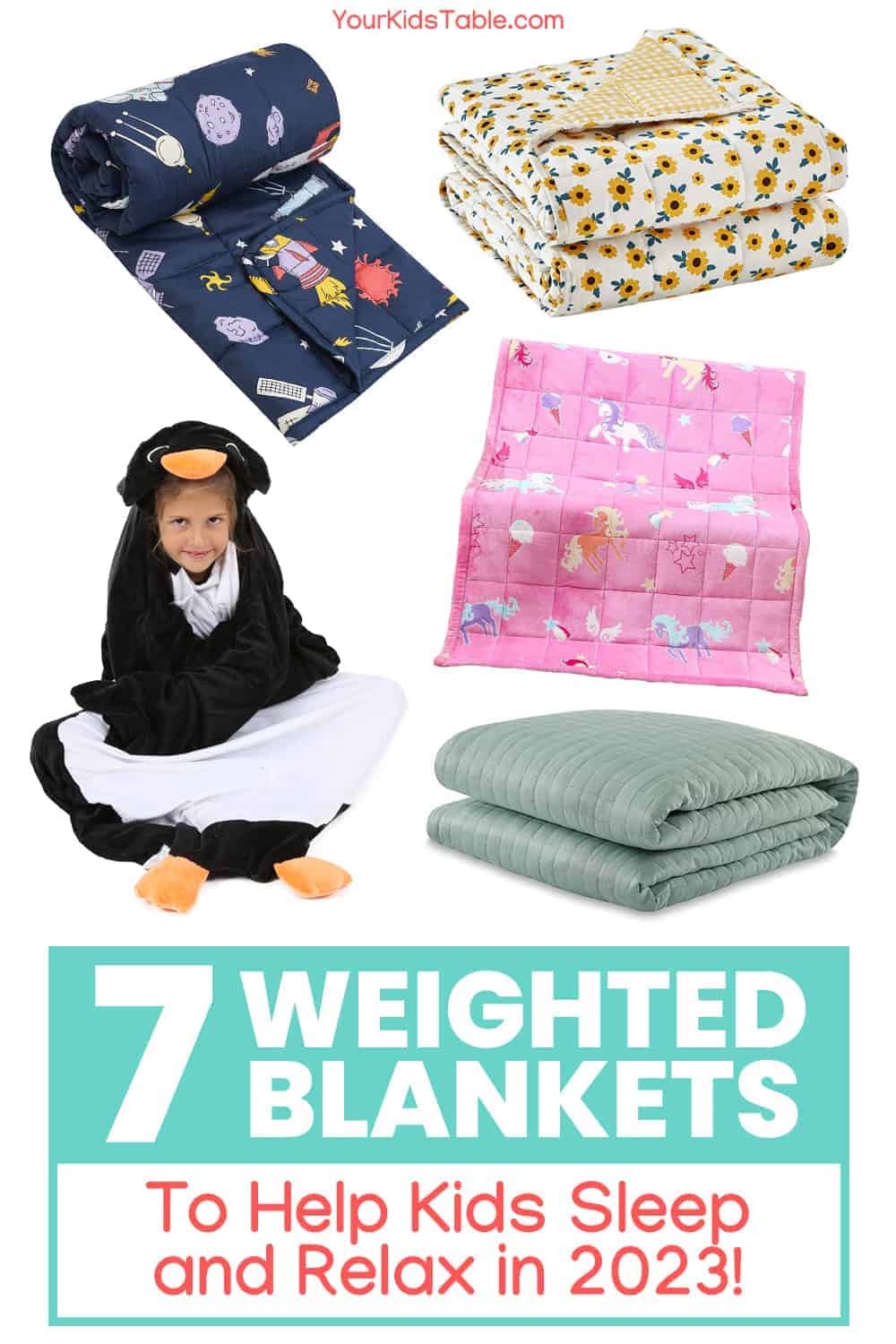
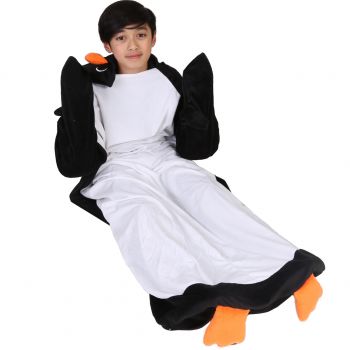
Love it thank you for the tips. A pricey option is Bearaby, but what I like is that my kid is a blanket chewer and I was worried about the beads. With a knitted weighted blanket she can play with the holes in it, however, for nighttime sleeping I would use it in a duvet for safety.
Hi there! So glad you enjoyed this post! Thanks for your feedback- that sounds great!
Best,
Kalyn
Hi, in no way am I an OT or a chiropractor but another parent just trying to learn more and help otger parents. Which is why I also wanted to share that if your child is having behavior or sleep issuses an avenue to try is chiropratice care, specifically ones that focus on the neck, called Upper Cervical portion of the body. I was really worried about my child and after receiving this care myself and talking to the chiropractor more I decided to have my son checked out. Turns out his neck was also out of alignment (which can happen quite frequently starting at birth since you know babies come head first) and after getting my son in for regular adjustments, we saw a world of difference in his sleep. It truly has been a game changer for us. So something else to consider.
Hi there! Thanks for reaching out and sharing this helpful information! Definitely another aspect to consider and worth exploring in some situations!
Best,
Kalyn
Any articles indicating how long you should allow child/toddler to lay under blanket ? Is there a time suggestion?
Hey Lisa,
The time frame would be specific to eat kiddo and each activity that you’re using it for. So if your child is using it in their lap to calm down while completing some work, then you would use it a bit before and for the duration of the activity. If you have a child who is having a meltdown and uses it to calm, then you would let them use it as long as they need it to regulate their sensory system. Or if you have an older child that prefers it for sleep, that is also fine. I hope that helps!
Best,
Andrea
Are you aware of any scientific journal articles that provide information about weighted blanket recommendations? If so, could you please share?
Hey Stephanie,
As for the recommendation for the amount of weight, it’s just a standard of practice that many professionals follow. We do not have any articles referencing the amount of weight. Definitely a need in this area!
Best,
Desiree
This is a great article about what a weighted blanket is and how it should be used.
We’ve used sensory blankets with minky dots for extra sensory stimulation on our blankets and it really is a gamechanger for kids.
Thanks so much for the tip!!
Best,
Desiree
I have two boys 9 and 11 and was given 15 lb blankets for them they are 65 lbs each is this too heavy of a blanket for them
Hey Amanda,
Our recommendation for weighted blankets is for each child to have a blanket that is 10% of their body weight plus 1 pound. Hope that helps!
Best,
Desiree
I have a 12 lb blanket that my 9 yr insisted on sleeping with, she weighs about 55 lbs, should I take it away?
We only recommend utilizing blankets that are 10% of their body weight, plus 1 pound.
Best,
Desiree
So you put sheet over them first then the weighted blanket is that right
Hey Nicole,
You can still utilize a sheet under the weighted blanket if you’d like!
Best,
Desiree
What weight would I use for a 19 month old who weighs just about 18lbs slightly over she’s very petit but feel like she could benefit from one just reading this article
Hi,
We always recommend a weighted blanket that is 10% of your body weight plus 1 pound! Hope that helps!
Best,
Desiree
Thank you!!
To be honest I used just a nice quilt purchased at target for $99 that usually drapes the end of my bed in the winter and fall. One night we put her in her toddler bed (which is on the other side of our bedroom) and I covered her with it because it was larger than her blankets. I noticed she napped much more sound on my bed under it. Turns out that night she slept straight thru! Never climbed in our bed halfway thru and never did her clockwise shuffle. You know…the clockwise/counter-clockwise toddlers do all night sometimes ending up on the floor or half on the bed and half off lol. It was like magic. Now she falls asleep faster and sleeps more sound. She’s less cranky in the AM and after naps whereas before it was as if she never had enough rest. I’ll be singing the praise of weighted blankets forever.
YAY Aaliyah, so happy you found what works for your daughter!! This is GREAT!
– Desiree
My niece loves her weighted blanket.
Can you sit on top of a weighted blanket as well as having it around you?
Yes, absolutely. You can use it exactly the same way you would a regular blanket, a weighted blanket is just heavier.
I bought this weighted blanket for girls (from here -https://hazlicollection.com/collections/best-sellers/products/weighted-blanket-for-girls-7lbs-pink-cotton-blanket#shopify-product-reviews ) after reading several guides.
The material is durable and my little girl loves it.
At night she covers herself with it, but during the day she sits above her and so far there have been no problems with the weight insertions of the blanket.
Alisha,
This is my first time on your blog and really appreciate all the information you share about the benefits of weighted blankets and lap pads. I am very passionate about providing children and adults with quality, affordable weighted products. Three years ago I started making weighted blankets and lap pads. I would like to expand my business and was wondering if you have any suggestions? I currently have a FB page: Simply Weighted Solutions which is my main way of marketing.
Target has them now!!!! 12 and 15 pound sizes, glass beads as the weights. They’re on sale for Black Friday too
You should use plastic pellets instead of food products. They are washable, easy to weigh, and do not attract insects.
I am glad I found you online. I was looking for sensory fall activities for toddlers and then I found your blog to be very informative. I have a little guy who may need a weighted blanket since he can’t fall asleep. Thanks for all the info so I can be better equip to buy what he needs.
Thanks Mel! I’m glad you’re here! Let me know if you have any questions.
CAN YOU USE DRIED BEANS FOR WEIGHTED BLANKETS?
I never have, but I’ve seen it done many times. It should work great!
It would be hard to wash. I always think about juice, milk, and vomit. How will I keep it clean?